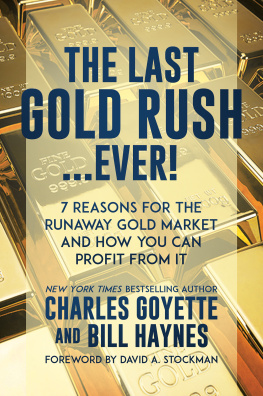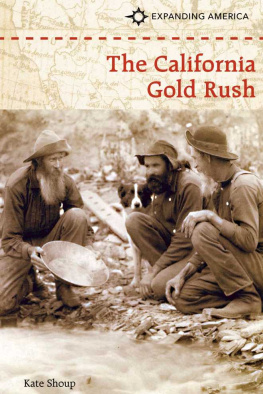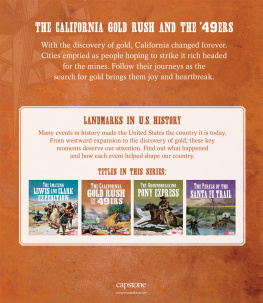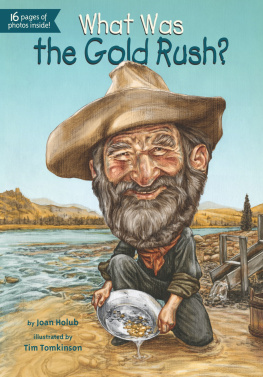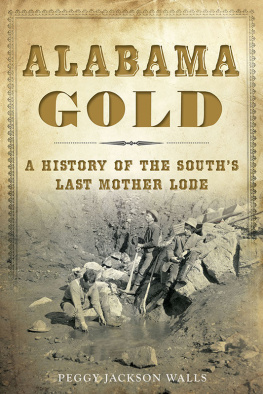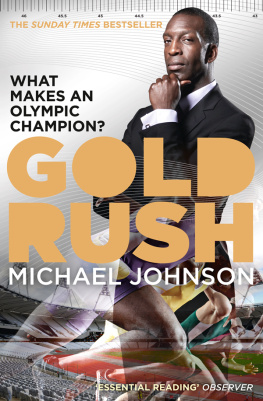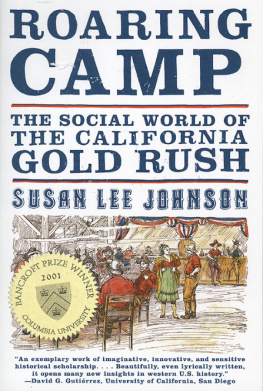
IMAGES
of America
OLIVES IN
CALIFORNIAS
GOLD COUNTRY

The region traditionally considered Californias Gold Country has been outlined in black on this 1898 map. While the focus herein is on the counties of Mariposa, Tuolumne, Calaveras, Amador, El Dorado, Placer, Nevada, Sierra, Yuba, and Butte, this book also delves into adjacent counties, including Sacramento, Tehama, San Joaquin, and Stanislaus, among others elsewhere in the state. (Authors collection.)
ON THE COVER: Olives, technology, and man are the basic elements that create the olive culture, and all three are shown together is this early-20th-century photograph of olive oil production at the Ehmann Olive Company plant in Oroville, Butte County. (Courtesy Butte County Historical Society.)
IMAGES
of America
OLIVES IN
CALIFORNIAS
GOLD COUNTRY
Salvatore Manna and Terry Beaudoin

Copyright 2014 by Salvatore Manna and Terry Beaudoin
ISBN 978-1-4671-3166-7
Ebook ISBN 9781439645789
Published by Arcadia Publishing
Charleston, South Carolina
Library of Congress Control Number: 2013952057
For all general information, please contact Arcadia Publishing:
Telephone 843-853-2070
Fax 843-853-0044
E-mail
For customer service and orders:
Toll-Free 1-888-313-2665
Visit us on the Internet at www.arcadiapublishing.com
Melinda Jane Gardner, the love of my life
Sal Manna
My wife, Sharon, and children Michael and Meaghan
Terry Beaudoin
CONTENTS
ACKNOWLEDGMENTS
Along with those thanked herein with courtesy credits for providing the photographs in this book, the authors wish to especially thank the Sammis family, who graciously provided the largest collection of photographs to ever document an olive orchard in the Gold Country, as well as Ken and Leann Evoniuk, whose resurrection of the Sammis olive orchard, called Rocca Bella, provided the original rationale for this book. Also indispensable were the cooperation and archives of the Society for the Preservation of West Calaveras History (westcalaverashistory.org), with SPWCH as the most frequent photograph courtesy credit throughout. In addition, thanks are given to Shannon Van Zant, Calaveras County archivist; the Derivi family, particularly Charlotte, for sharing her grandfathers olive legacy; Nick Baptista and Vip Hale of the Valley Springs News, for their support and publication of Sal Mannas Something From Nothing column, where the first historical articles about Rocca Bella appeared; Vera Bogosian, for allowing Terry Beaudoin to care for her olive trees; George Hoag, master processor and Terrys brother in olives, for sharing just a bit of his vast knowledge of the olive industry and its history; Dr. Julia Costello; Judith Marvin; Debbie Poulsen of the Placer County Museums; Lucy Sperlin, Nancy Brower, and Sally McCoy at the Butte County Historical Society; Carolyn Fregulia and her Italians of the Gold Country book; Dan Flynn, executive director, Olive Center at the Robert Mondavi Institute for Wine and Food Science, University of California at Davis; William H. Krueger, director for Tehama and Glenn Counties, University of California Cooperative Extension; and author Judith Taylor, whose The Olive in California was the first book to venture into the states olive culture. On more personal notes, Sal thanks his mother, Mary, and sister, Dee, for their love and support. Terry thanks his daughter, Meaghan, for the inspiration that started him in the world of olives; his son, Michael, for his help in picking the olives; and his wife, Sharon, for giving him the time to follow his passion.
Unless otherwise noted, all images are from the authors collection.
INTRODUCTION
Oh, the olive, it is historys fruit. Native to eastern Mediterranean and western Asia, the olive tree was first cultivated more than 6,000 years ago, providing food and, with its oil, cooking fat as well as illumination for lamps. In ancient Greece, olive oil was also used to anoint kings and was burned to provide the eternal flame of the original Olympic Games, where victors were crowned with olive leaves. Grecians rubbed olive oil on their bodies for health and on their hair for grooming. Olive trees were so prized that anyone who cut one down was condemned to death or exile. Homer referred to olive oil as liquid gold. Athens is named for the goddess Athena, who myth says brought the olive to the Greeks as a gift, planting the original tree on a rocky hill later known as the Acropolis.
Both the Old and New Testaments of the Bible invoke the olive. In fact, the olive was proclaimed the most important tree for the Israelites: The trees went forth on a time to anoint a king over them; and they said unto the olive tree, reign thou over us (Judges 9:8). King David had guards watch over olive groves and warehouses to ensure their safety. For Christendom, the Mount of Olives east of Jerusalem remains today one of its holiest sites. The olive is praised in the Quran as well, and the prophet Muhammad is reported to have called it a blessed tree.
The olive has spanned time as a sign of peace, offering an olive branch, as on the Great Seal of the United States; prosperity, A land of corn and wine, a land of bread and vineyards, a land of oil olive and of honey, that ye may live, and not die (2 Kings 18:32); plenty, Thy wife shall be as a fruitful vine by the sides of thine house: thy children like olive plants round about thy table (Psalms 128:3); and providence, And the dove came in to him in the evening; and, lo, in her mouth was an olive leaf pluckt off: so Noah knew that the waters were abated from off the earth (Genesis 8:11). As Judith Taylor writes in her seminal book The Olive in California: History of an Immigrant Tree, No other food of equal of greater antiquitywith the possible exception of the grapeis surrounded by the same aura of myth and romance.
As a commodity in the ancient world, clay jars filled with olive oil were traded across long distances, most notably by the Phoenicians. Those enterprising people spread the olive throughout the known world at the time, including Egypt, where olive branches were found in King Tuts tomb. The olive migrated from Greece to Rome as the latters hegemony expanded, including to North Africa and what is today France and Spain. Olive culture survived the fall of the Roman Empire and the subsequent Dark Ages. Soon after the Spanish crown ventured into the New World, beginning with the 1492 voyage of Christopher Columbus, the olive arrived in the Western Hemisphere.
One of the worlds oldest cultivated fruits, the olive is an example of the Columbian exchange, the transfer of plants and animals between the Old and New Worlds, as when Spain provided olive trees from orchards near Seville to the intrepid settlers of Hispaniola and Cuba. The thrust of settlement, however, soon shifted to the larger mainland of New Spain, todays Central and South America. Along with the military conquest of the Aztecs of Mexico came spiritual conquest by missionaries of the Catholic Church. These priests, such as Franciscan father Martin de Valencia, who planted olive trees when he arrived in New Spain in 1524, were responsible for cultivating the olive orchards that sprang up in Baja California. Missionaries of the Society of Jesus (Jesuits) took over that task some 50 years later. A century further on, Jesuit father Juan Maria Salvatierra founded a mission at Loreto on the eastern shore of Baja California in 1697 and then five others. The olive trees he grew, from pot cuttings or olive slips (pieces of stem with a few leaves, grown from a mother root) taken from orchards around Mexico City, would become the immediate source of the first olive trees introduced in what the Spanish called Alta California.
Next page

